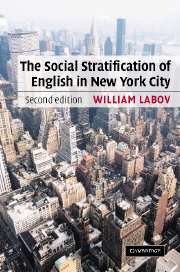Book contents
- Frontmatter
- Contents
- Introductory note
- Preface to the first edition
- Preface to the second edition: forty years later
- I Problems and methods of analysis
- II Social differentiation
- III Social evaluation
- 11 Subjective evaluation of the variables
- 12 Self-evaluation and linguistic security
- 13 General attitudes towards the speech of New York City
- IV Synthesis
- Glossary of linguistic symbols and terminology
- Appendix A Questionnaire for the ALS Survey
- Appendix B Anonymous observations of casual speech
- Appendix C Analysis of losses through moving of the MFY sample population
- Appendix D Analysis of the non-respondents: the television interview
- Appendix E The out-of-town speakers
- Bibliography
- Index
12 - Self-evaluation and linguistic security
Published online by Cambridge University Press: 18 December 2009
- Frontmatter
- Contents
- Introductory note
- Preface to the first edition
- Preface to the second edition: forty years later
- I Problems and methods of analysis
- II Social differentiation
- III Social evaluation
- 11 Subjective evaluation of the variables
- 12 Self-evaluation and linguistic security
- 13 General attitudes towards the speech of New York City
- IV Synthesis
- Glossary of linguistic symbols and terminology
- Appendix A Questionnaire for the ALS Survey
- Appendix B Anonymous observations of casual speech
- Appendix C Analysis of losses through moving of the MFY sample population
- Appendix D Analysis of the non-respondents: the television interview
- Appendix E The out-of-town speakers
- Bibliography
- Index
Summary
Chapter 11 demonstrated that New Yorkers showed surprisingly consistent response to the subjective reaction test. In their reactions to the speech of other New Yorkers, they detected stigmatized features with great regularity, and demonstrated uniform recognition of prestige markers.We were able to measure these reactions, despite the fact that few of the respondents consciously perceived the values of the variables which caused their reactions.
In the conscious report of their own usage, however, New York respondents are very inaccurate. There is little correlation between their selfevaluation and their use of the five variables, in any style. Nevertheless, we can learn a great deal about attitudes towards the variables from these reports. For this reason, the test to be described is not referred to as a “Selfrecognition test,” but rather a “Self-evaluation test.”We shall see that when average New Yorkers report their own usage, they are basically giving us their norms of correctness. There is no conscious deceit in this process. It appears that most New Yorkers have acquired a set of governing norms which they use in the audio-monitoring of their own speech. We have reason to believe that the process of stylistic variation described in Part II of this work is governed by the degree of audio-monitoring which is superimposed upon the motor-controlled patterns of native speech. The audiomonitoring norm is the form which is perceived by speakers themselves as they speak. They do not hear the actual sound which they produce, but the norm which they impose. We will return to this hypothesis after the evidence on self-evaluation and linguistic security has been presented.
- Type
- Chapter
- Information
- The Social Stratification of English in New York City , pp. 300 - 323Publisher: Cambridge University PressPrint publication year: 2006



